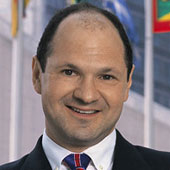How Russia Met the World
Why has Russia historically been so slow to adopt Western ideas?
August 3, 2004
Russia has always been a remote and self-contained land. And while it spans an enormous geographical expanse between Europe and Asia, for most of its history it never fully belonged to either.
Instead, Russia has always been a continent all its own, existing in isolation from the rest of the world. For most of its history, that isolation has been largely self-imposed.
Moreover, this isolation — although enforced by the czars until the 1917 revolution and thereafter by the Communist leaders of the Soviet Union — was not exclusively mandated from above.
The truth is that the trend toward isolationism came in equal measure from below, as well. Ordinary Russians felt simultaneously attracted and repelled by the West. They felt that Russia was different — and in many ways better, purer and more spiritual — than the decadent, materialistic West.
One single, striking document may explain a lot about modern-day Russia. It is a map of the world published in Russia in the first half of the 18th century.
It was a time when France was going through Enlightenment, when Voltaire and Rousseau were writing their great works. And in the United States, most of the Founding Fathers had already been born.
Even in Russia, the German-born Empress Catherine the Great maintained a lively intellectual correspondence with many of the enlightened French philosophes, discussing some of the most advanced ideas of their time.
Yet, the 18th century Russian map shows a circular view of the world — and one that had been pretty much unchanged from the times of Ptolemy, the 2nd century A.D. Greek astronomer.
The map presents the earth as the immobile center of the universe around which the sun, the planets and even distant stars rotate. In the West, Ptolemaic astronomy had become obsolete by the year 1500, a century before the great discoveries of Galileo.
It is no coincidence that the time lag between Russia and the West measures around two centuries. This is how long Russia remained under the domination of Tatar-Mongol invaders.
What the Russians called the "Tatar Yoke" lasted from the rise of Genghis Khan in 1206 to the historic defeat of the Tatars at Kulikovo in 1380. The initial opening to the West began just 70 years later — around 1450.
Unlike other nations, which rushed to rejoin the West the moment they were freed, Russia's turn to the West was only very gradual. Russians clung stubbornly to their own ideas, customs and — most important — religion for centuries.
A key event in Russia's opening to the West came easily enough, with the marriage of Sofia Palaeologus — the niece of the last Byzantine Emperor — to Czar Ivan III in 1472.
Significantly, the Italian architect Ridolfo Aristotelo Fioravanti was invited to build churches and bell towers in the Kremlin in 1475. In his native Bologna, the Renaissance was in full bloom and Italy had already emerged as a European artistic and cultural center.
Yet, rather than exporting Renaissance architecture to Russia, Fioravanti — as his work in the Kremlin plainly shows — had to adapt his style to local Russian traditions.
Even after Peter the Great pushed Russia toward the West with great determination, founding a new capital, St. Petersburg, on the shores of the Baltic Sea in 1703, the country remained ambivalent about Western influences.
The 1825 Decembrist rising against Czar Nicholas I marked the first time Western ideas of democracy and freedom truly began to take root in Russia following the invasion and defeat of Napoleon (1812-1815).
During the 19th century, Russia was no longer engaging the rest of Europe. It became part of Europe, one of the Great Powers playing an important political and military role on the continent. It also fully adopted European institutions, dress and customs.
But all that change was apparently only skin-deep. It is ironic that Communism, claiming to be the first truly international movement, ended up not only reverting to isolationism — but taking it to a new height by drawing the Iron Curtain across Europe.
Even after the Soviet Union imploded in the early 1990s, the enduring strain of suspicion toward foreigners and ambivalence about opening up — which has run throughout Russia's history ever since it made first contacts with the West in the 15th century — has continued.
Read previous
How Japan Embraces China
August 2, 2004
